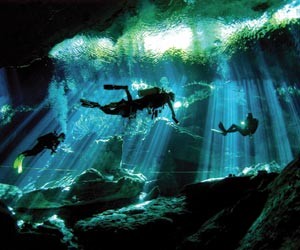Far from its roots as an isolated center for the Maya people, Mexico’s Riviera Maya now goes toe-to-toe with the country’s major resort towns when it comes to amenities and activities. And the region is just getting started.
Stretching some 100 miles south of Cancun along the Caribbean coast, Riviera Maya runs roughly from Puerto
Moreles past Tulum to Punta Allen, a fishing village within the Sian Ka’an Biosphere Reserve. Centuries ago, the Maya people flocked here from all over the Yucatan Peninsula to purify themselves in the waters of the cenotes and afterward sailed in canoes to the nearby island of Cozumel to worship Ix Chel, goddess of the moon.
Despite its picture-perfect location, Riviera Maya was more an afterthought to Cancun than its own entity until access to the area began to open; a little less than 20 years ago the unnamed expanse received its sophisticated moniker.
"Seventeen years ago we were talking about maybe 2,000 hotel rooms, mostly small hotels developed by local families," says Javier Aranda, general director of the Riviera Maya Tourism Board. "It has grown to 37,200 rooms in 350 hotels. The development that we have done in the area is completely different from Cancun. If hotels are not in the main city of Playa del Carmen, they are mostly in the jungle. You don’t see them until you get into the property, so you never feel crowded."
Visitors find hotels ranging from three stars in Playa del Carmen, formerly a sleepy fishing village, to luxury brands like Mandarin Oriental and Iberostar, as well as Mexican chains like Palace and Real resorts. New resorts include Grand Velas All Suites & Spa Resort Riviera Maya, and the upcoming Azul Fives Hotel in Playa del Carmen.
No less than four golf courses are under construction, including a course at the upcoming Capella Bahia Maroma Riviera Maya, located on one of the Riviera Maya’s most pristine beachfronts, Maroma Beach, across from the world’s second-largest coral reef.
Also in the works is the new Riviera Maya International Airport, which will be located close to Tulum and developed in three to four years, according to Aranda. In the meantime, Cancun International Airport is opening a new runway in October.
"Riviera Maya now is more of a cosmopolitan destination—people come from all around the world to live here, but we’re in the middle of the heart of the Maya world, so it is a mixture between modern and old cultures," Aranda says.
Still, Mayan culture and outdoor adventure continue to define Riviera Maya. Within easy reach are the archaeological sites Tulum and Coba, and even day trips to Chichen Itza are popular. The community of Tihosuco, near Tulum, is one of the oldest villages in the state of Quintana Roo and famous for its colonial buildings. Group visits include a performance showing the local traditions from Hispanic times combined with a dinner.
Popular culture is also taken seriously, as Riviera Maya plays host to a number of festivals, such as the Riviera Maya Underground Film Festival and Riviera Maya Jazz Festival, among others.
Of the many eco-parks, Xel-Ha remains one of the most popular for its network of coastal channels and lagoons. Mayan for "Where the water comes in," it offers thrills like 15-foot dives off the Cliff of Courage or snorkeling in what amounts to nature’s aquarium.
Standard for any Riviera Maya stay is a visit to Xcaret, which blends outdoor pursuits with Mayan culture. New this year is a sea turtle exhibition as well as the opening of The Museum of Popular Mexican Arts. djacent to Xcaret, Xplor opened in July and takes the adventures underground through rivers and caverns with options for swimming and rafting.
According to Aranda, Riviera Maya will also benefit from government plans to further develop the Grand Costa Maya, which stretches from Punta Herrero—about five hours south of Cancun—to the border with Belize. He predicts Tulum in particular will see a boost in visitors, meaning investment and growth in this region is far from over.







